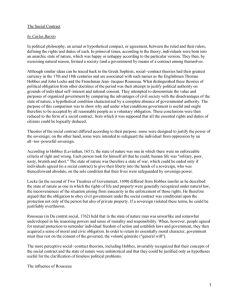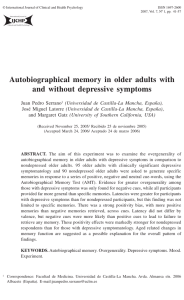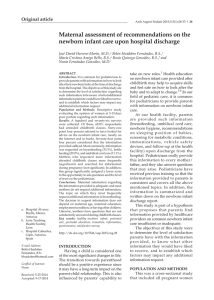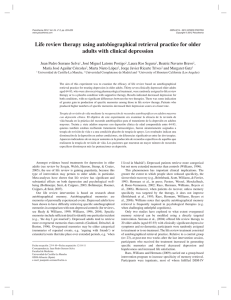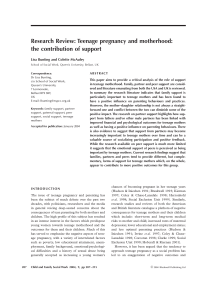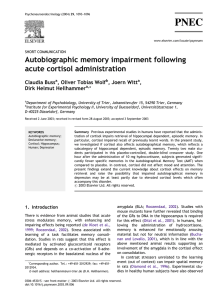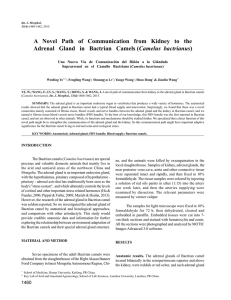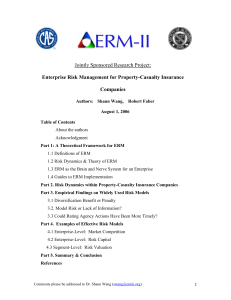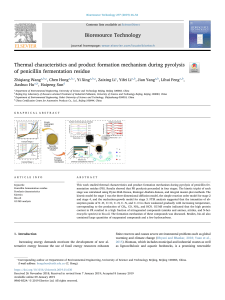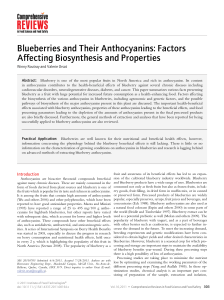The Way She Speaks - Cornell College of Human Ecology
Anuncio
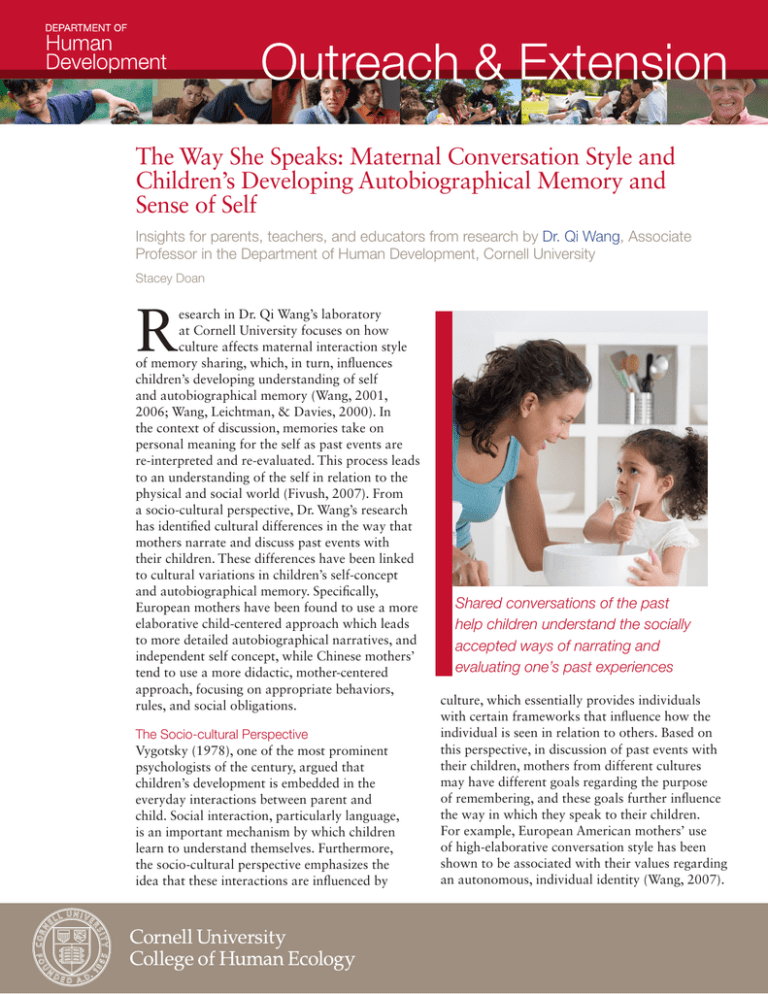
The Way She Speaks: Maternal Conversation Style and Children’s Developing Autobiographical Memory and Sense of Self Insights for parents, teachers, and educators from research by Dr. Qi Wang, Associate Professor in the Department of Human Development, Cornell University Stacey Doan R esearch in Dr. Qi Wang’s laboratory at Cornell University focuses on how culture affects maternal interaction style of memory sharing, which, in turn, influences children’s developing understanding of self and autobiographical memory (Wang, 2001, 2006; Wang, Leichtman, & Davies, 2000). In the context of discussion, memories take on personal meaning for the self as past events are re-interpreted and re-evaluated. This process leads to an understanding of the self in relation to the physical and social world (Fivush, 2007). From a socio-cultural perspective, Dr. Wang’s research has identified cultural differences in the way that mothers narrate and discuss past events with their children. These differences have been linked to cultural variations in children’s self-concept and autobiographical memory. Specifically, European mothers have been found to use a more elaborative child-centered approach which leads to more detailed autobiographical narratives, and independent self concept, while Chinese mothers’ tend to use a more didactic, mother-centered approach, focusing on appropriate behaviors, rules, and social obligations. The Socio-cultural Perspective Vygotsky (1978), one of the most prominent psychologists of the century, argued that children’s development is embedded in the everyday interactions between parent and child. Social interaction, particularly language, is an important mechanism by which children learn to understand themselves. Furthermore, the socio-cultural perspective emphasizes the idea that these interactions are influenced by Shared conversations of the past help children understand the socially accepted ways of narrating and evaluating one’s past experiences culture, which essentially provides individuals with certain frameworks that influence how the individual is seen in relation to others. Based on this perspective, in discussion of past events with their children, mothers from different cultures may have different goals regarding the purpose of remembering, and these goals further influence the way in which they speak to their children. For example, European American mothers’ use of high-elaborative conversation style has been shown to be associated with their values regarding an autonomous, individual identity (Wang, 2007). Development of Children’s Ability to Participate in Reminiscing The process of sharing memories between mother and child begins early in development. As soon as children become capable of using language to express themselves they begin to participate in discussing past events with caregivers. At about 18–20 months children can refer to the immediate past, but at this stage they actually make very few spontaneous, in-depth references to past events. At about 20–36 months, children can provide simple responses to parents’ questions about the past. It is not until about 3–5 years of age that children are able to engage in more detailed conversations about the past. However, even at this age they rely on adults to scaffold, or provide most of the structure and content. By the time children are about 5–6 years of age, they are able to independently provide increasingly rich narratives about their past. Cultural Differences in Maternal Reminiscing Style Research of mother–child memory sharing has identified two distinct conversational styles (Fivush & Fromhoff, 1988; Fivush, Haden, & Reese, 2006). Mothers who engage their children in a “high-elaborative” conversational style frequently ask wh-questions (i.e., where, when, what, who, how, why), provide feedback and encouragement, and supplement information whenever the child fails to respond. In contrast, mothers who engage their children in a “low-elaborative” conversational style often repeat their pointed questions without providing embellishment or feedback. While these different conversational styles can vary within a single culture, cross-cultural studies have shown that European American mothers are generally more elaborative than Korean, Chinese, and Japanese mothers. For instance, in studies of memory conversations between American and Chinese mothers and their 3-year-old children, Wang and colleagues (Wang, 2001, 2006; Wang, Leichtman, & Davies, 2000) found that American mothers often used a high-elaborative conversational style, where they talked at length with their children about the past event, supplemented children’s responses with rich and embellished information, and provided immediate feedback to encourage children’s participation. In contrast, Chinese mothers tended to use a lowelaborative conversational style, where they directed the conversations by posing and repeating factual questions, provided little detail and embellishment, and often carried out the conservation in didactic style. Furthermore, American mothers often took a childcentered approach, where the child was the focal point 2 of the conversation and the talk surrounded the child’s interests, preferences, opinions, and personal attributes (Wang, 2001; Wang et al. 2000). In contrast, Korean (Mullen & Yi, 1995) and Chinese (Wang, 2001; Wang et al. 2000) mothers often took a mother-centered approach, where the mothers set the direction for the conversation and emphasized interpersonal relations, moral rules, and behavioral expectations. Child-centered approaches, where mothers scaffold, interact with the child, and elaborate on past events have been associated with a variety of social emotional outcomes, including more detailed memories and coherent sense of an individual self. Effects of Maternal Reminiscing Style on Autobiographical Memory The stylistic and content differences in mother–child memory sharing can have direct consequences for children’s autobiographical memory operations. Shared conversations of the past help children understand the socially accepted ways of narrating and evaluating one’s past experiences as well as how to incorporate past experiences into one’s personal life story (Nelson & Fivush, 2004). High elaborative mothers in essence scaffold their children’s narrative abilities through the type of questions they ask and the information they provide. In addition, through evaluations and feedback, highly elaborative mothers indicate valuing their children’s participation. Finally, a child-centered approach emphasizes the importance of individual experience; specifically the function of reminiscing becomes intertwined with the conceptualization of the self (Wang, 2006, 2008). Studies by Wang and colleagues have rendered empirical support to these cross-cultural differences in autobiographical memory. When asked to recount their past experiences, European American preschool and grade school children often provided more elaborate and detailed memory accounts than did Chinese and Korean children (Han, Leichtman, & Wang, 1998; Wang, 2004). The American children also recollected more about specific past events than the two groups of Asian children, who recollected more about daily routines. Furthermore, American children referred more frequently to their own roles, preferences, and emotions than did Chinese children, who talked more about other people rather than themselves in their memory narratives. Collectively, these findings suggest that the style that mothers use and content that mothers focus on during memory conversations with their children may have enduring effects on children’s own memory operations. Interestingly, these cultural differences in children’s memory appear to extend to adulthood. In a study where college-aged students were asked to report their earliest childhood memory, Wang (2001) found that Americans reported lengthy and specific accounts of memories that are self-focused and emotionally elaborated. Chinese, on the other hand, reported brief accounts of memories that are centered on general routines, are collectivefocused and emotionally neutral. In another study, Wang and Conway (2004) examined the autobiographical memory of middle-aged adults who were each asked to recall 20 memories from any period of their lives. Not surprisingly, Americans provided more memories of individual experiences and unique, one-time events that focused on their own roles and emotions, while Chinese provided more memories of social and historical events that focused on social interactions and significant others. Collectively, these findings suggest that cross-cultural differences in autobiographical memory are evident early in life and last through life. Self Development In addition to autobiographical memory, mothers’ conversational style may influence a child’s self-concept. Autobiographical memory has been referred to as the “extended self” or the “remembered self,” and is believed to be closely intertwined with the self-concept (Conway & Pleydell-Pearce, 2000). While our self-concept shapes how we remember our experiences, our memories in turn help to define who we are. Importantly, the way that an individual comes to understand him- or herself is deeply rooted in the culturally prevailing views of selfhood. The promotion of individuality, self-expression, and personal agency attributes that are prized in Western cultures, often facilitates the development of an independently oriented self that is well-bounded, separate, and distinct from other people. In contrast, the promotion of communality, interpersonal harmony, and personal humility attributes that are valued in East Asian cultures, often encourages the development of an interdependently oriented self that is fused within a complex web of relationships and social networks. (Markus & Kitayama, 1991). Cultural differences in the conceptions of self have long been documented to influence a wide array of psychological processes (Markus & Kitayama, 1991). Pertaining to the current analysis, differences in the cultural conceptions of self hold important implications for memory. An independent self-construal, how the self is represented, focuses on the self as a unique entity with particular qualities and attributes that would facilitate attention to and encoding of relevant information that is specific to the self. On the other hand, an interdependent self-construal constituted primarily by social roles and obligations may place precedence on retaining information important for maintaining social harmony and understanding one’s relations to others (Mullen, 1994; Wang, 2001; Wang, 2004). Mothers in conversation with children emphasize different components of the past. In socializing an independent self-construal, Western mothers are more likely to focus on the child’s internal states. Specifically, the child is encouraged to talk about and reflect on how they felt in a past event. Mothers ask about and encourage children to express their opinions and concerns. Later on when children are able to speak about their own memories, they similarly have a self-focus, discussing their own internal states, preferences, and feelings. Chinese mothers, on the other hand, are more likely to focus on children’s behaviors, frequently discuss how their actions may influence other people, and bring up social events rather than events personal to the child. Tips for Parents and Child Educators • Consider your goals before starting a discussion with your child. What aspects of the event do you think is important for your child to remember? To what extent do you think you should focus on the child’s thoughts, feelings, and desires or how their behavior has an influence on others? • Set aside a quiet time to discuss past events with your child. For younger children, events where both parent and child were present will allow parents to do more scaffolding and structuring of the conversation. • Consider the type of events you wish to discuss with your child and their implications. Selecting social events would allow you to reflect on your child in relation with others, social norms, and behavioral expectations. Choosing a personal event would allow you to focus on your child’s experiences, thoughts, and feelings relating to the event, and how this event may influence the child’s perception about him/herself. • Discuss one-time, relatively novel events, rather than daily repeated activities. Children sometimes have difficulty teasing apart events that occur on a daily basis. • Ask a lot of “wh” questions (e.g., who, what, where, when, why). Provide answers when the child does not remember. Avoid repeating questions, or “looking” for a right answer. Try not to create a test-like atmosphere. 3 • You can choose to focus on the child’s thoughts and feelings, by asking what they particularly liked, how they felt, and drawing out their thoughts. This type of conversational focus instills children with an autonomous, independent sense of self, and elaborative autobiographical memory. Alternatively, if your concern is for your child to understand behavioral norms and social rules, focus on their specific behaviors, how their behaviors might have affected others, and what they would do differently or similarly. Conclude with “lessons learned.” This type of conversation aids children in focusing on the self in relation to others, and encourages an interdependent self-concept. • Provide positive feedback when your child participates and be responsive to their contribution to the conversation. • Most importantly, have fun and engaging conversations. Demonstrate to your child that you are invested and interested in their life! Resources Dr. Qi Wang’s Social Cognition Website (http://www. human.cornell.edu/hd/socialcognition/index.cfm) References Conway, M. A., & Pleydell-Pearce, C. W. (2000) The construction of autobiographical memories in the self memory system. Psychological Review, 107, 261–288. Fivush, R., & Fromhoff, F. A. (1988). Style and structure in mother–child conversations about the past. Discourse Processes, 11, 337–355. Fivush, R., Haden, C. A., & Reese, E. (2006) Elaborating on Elaborations: Maternal Reminiscing Style and Children’s Socio-emotional Outcome, Child Development, 77, 1568–88. Fivush, R. (2007). Maternal Reminiscing Style and Children’s Developing Understanding of Self and Emotion, Clinical Social Work, 35, 37–46. Mullen, M., & Yi, S. (1995). The cultural context of talk about the past: Implications for the development of autobiographical memory. Cognitive Development, 10, 407–419. Nelson, K., & Fivush, R. (2004). The Emergence of Autobiographical Memory: A Social Cultural Developmental Theory, Psychological Review, 111, 486– 511. Vygotsky, L. (1978). Interaction between Learning and Development (pp. 79–91 in Mind in Society, M. Cole trans.). Cambridge, Mass.: Harvard University Press. Wang, Q. (2001). “Did you have fun?” American and Chinese mother–child conversations about shared emotional experiences. Cognitive Development, 16(2), 693–715. Wang, Q. (2006). Relations of maternal style and child self-concept to autobiographical memories in Chinese, Chinese immigrant, and European American 3-year-olds. Child Development, 77(6), 1794–1809. Wang, Q. (2007). “Remember when you got the big, big bulldozer?” Mother–child reminiscing over time and across cultures. Social Cognition, 25(4), 455–471. Wang, Q., Leichtman, M. D., & Davies, K. (2000). Sharing memories and telling stories: American and Chinese mothers and their three-year-olds. Memory, 8(3), 159–177. Wang, Q., & Conway, M. A. (2004). The stories we keep: Autobiographical memory in American and Chinese middle-aged adults. Journal of Personality, 72(5), 911– 938. Wang, Q. (2008). Emotion knowledge and autobiographical memory across the preschool years: A cross-cultural longitudinal investigation. Cognition, 108, 117–135. Markus, H. R., & Kitayama, S. (1991). Culture and the self: Implications for cognition, emotion, and motivation. Psychological Review, 98, 224–253. Mullen, M. (1994). Earliest recollections of childhood: A demographic analysis. Cognition, 52, 55–79. Development of this publication was supported by Smith Lever funds from the Cooperative State Research, Education, and Extension Service, U.S. Department of Agriculture. Any opinions, findings, conclusions, or recommendations expressed here are those of the author(s) and do not necessarily reflect the view of the U.S. Department of Agriculture. For more information, visit the Human Development Outreach & Extension website where additional copies of this article and many other resources are available: http://www.human.cornell.edu/hd/Outreach_extension/index.cfm 4
